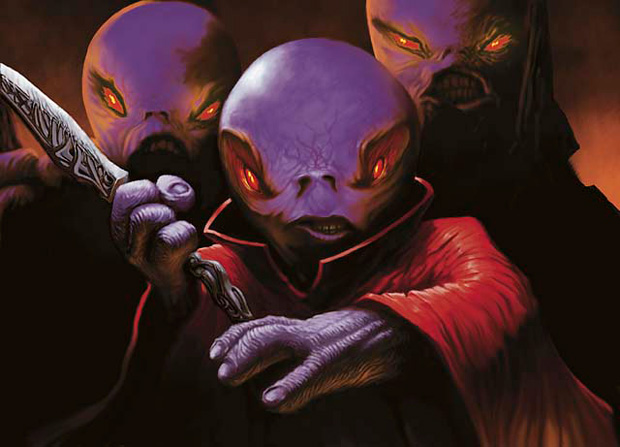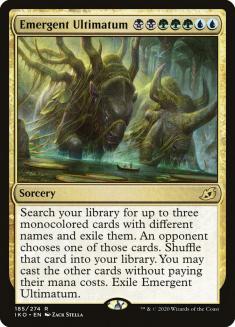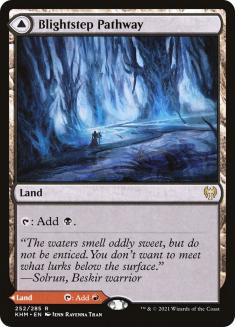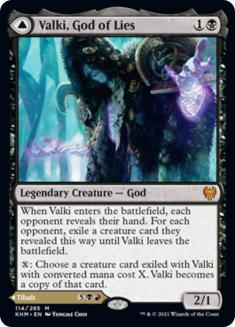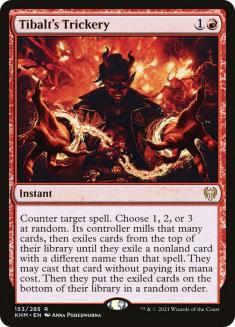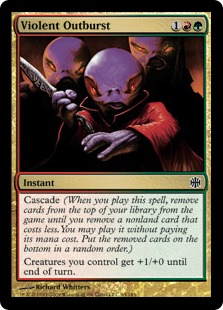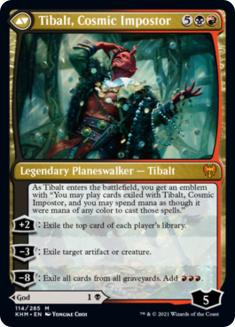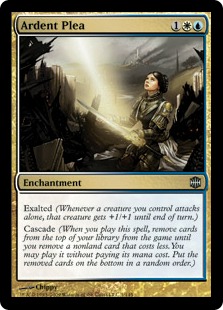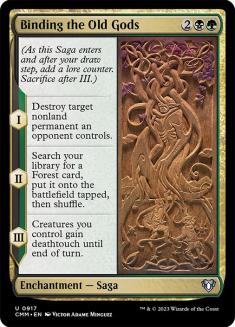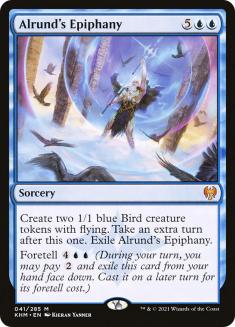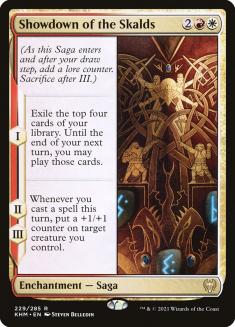CEDitor’s Note: Each portion of today’s Fact or Fiction was written without the knowledge that Uro, Titan of Nature’s Wrath is set to be banned in Pioneer, Modern, and Historic soon. We apologize for any inconvenience that may cause in enjoying this article.
Welcome to Fact or Fiction! Today, Ross Merriam, Ari Lax, and Paulo Vitor Damo da Rosa are here to give their takes on five statements about the impact of Kaldheim on Constructed Magic. Don’t forget to vote for a winner at the end!
1. Sultai Ramp (Yorion) based around Emergent Ultimatum is the current deck to beat in Kaldheim Standard.
Ross Merriam: Fiction. It’s the early days of a Standard environment, and that means things move quickly and decks rise and fall in a matter of days. The first deck to beat, Izzet Midrange, pushed people to pick up Dimir Rogues, which led to the rise of Rakdos Midrange, which in turn led people to pick up Yorion, Sky Nomad decks. Alongside this trend, various aggro decks, from Naya Adventures to Boros Aggro to Mono-Green Aggro, have seen success.
It’s going to take weeks to sort through the noise before a well-defined metagame takes shape. And until then, it makes little sense to talk about the best deck. I think Sultai Ramp (Yorion) is powerful, and likely better than Temur Ramp since black has access to better removal. Past that I’m not committing to anything.
Ari Lax: Fiction. None of the Yorion, Sky Nomad decks in Kaldheim Standard have a sustainable matchup against Showdown of the Skalds or Soaring Thought-Thief. Rakdos Midrange had a week to scare people off those and in turn got exploited by control decks, but that won’t last. It literally takes two sideboard copies of Klothys, God of Destiny to make Rakdos Midrange into a bad deck against Naya Adventures.
Dimir Rogues remains an absurdly good deck, and once it has room to breathe without 20% of its matches involving Kroxa, Titan of Death’s Hunger, the format will go back to figuring out the right midrange and aggro decks to play. Sultai will likely remain playable in some form, but it certainly won’t be the best deck in the format.
Paulo Vitor Damo da Rosa: Fiction. It’s waaay too early to be calling any deck in Kaldheim Standard the best deck. Right now, the format is still in an experimental stage and there are many viable strategies that could end up being the best deck — different Boros and Naya builds, Gruul Adventures, Dimir Rogues, several different Yorion decks (with or without Emergent Ultimatum), Rakdos Midrange, Izzet Snow❄, and so on. Sultai Ramp (Yorion) is a powerful strategy but there isn’t much evidence that it’s a step above any of the other current powerful strategies in Standard (and there isn’t really enough evidence that it’s even the best Yorion deck in the format, though it may very well be).
When the format settles, it wouldn’t surprise me if any of these decks ended up being the best, but it would also not surprise me if the format simply had no best deck. I think the pre-Kaldheim Standard format didn’t really have a best deck for most of its tenure (though Gruul Adventures was the best deck at certain points), so it’s definitely possible that there’s enough balance in Kaldheim Standard that we don’t see a best deck at all.
2. With the addition of Blightstep Pathway and Valki, God of Lies, a Rakdos-based strategy will become the deck to beat in Historic.
Ross Merriam: Fiction. This one is close, because I think Rakdos Arcanist is a very good deck that could benefit greatly from another quality dual land and Valki is another solid addition. I expect it to be among the most popular and best-performing decks in the metagame moving forward, so if you want to call that the best deck, then sure.
But I’m going to say Fiction on a technicality that it won’t quite reach the level of being a consensus top choice. The deck is weak to graveyard hate and Rakdos offers few answers to cards like Leyline of the Void. Also, I’m sure some mad scientist is hard at work finding a way to cheat Tibalt, Cosmic Imposter onto the battlefield and there’s probably some obscure card that was put into Historic in a super-secret Arena-only jump-around Remastered set that does it. So that’ll probably be the best deck because it’s 2021 and we can’t have nice things anymore.
Ari Lax: Fiction. I get that Valki, God of Lies is good against Uro, Titan of Nature’s Wrath, but you do know that Uro is legal for your own deck, right?
Paulo Vitor Damo da Rosa: Fiction. I think Historic has three Tier 1 decks right now — Sultai Midrange, Jund Sacrifice, and Gruul Aggro. Each of these decks, to me, has the ability to be the best deck in a given metagame, but they can all be reacted to with relative ease, so there’s no scenario where one is strictly dominant. There are also a lot of Tier 2 decks that are potentially playable (Goblins, Azorius Auras, Azorius Control, Rakdos Arcanist, Paradox Engine, etc.) and that could be the best deck in specific fields. This is the same as pre-Kaldheim Historic and I don’t believe the format is going to change a significant amount with the new set.
Blightstep Pathway and Valki, God of Lies are powerful cards and help some of the decks in the format, but not enough to justify putting any of them above all the others. I think there’s a chance that a Rakdos-based strategy is the best deck in the format (Jund Sacrifice, which is one of the decks I consider Tier 1), but that deck might not even play any of the new cards when all is said and done, so I think in the spirit of the question I should answer Fiction even if I think that deck is one of the best.
3. Tibalt’s Trickery should be banned in Modern.
Ross Merriam: Fiction. I’m already sick of this nonsense, and it needs to stop. But Tibalt’s Trickery isn’t the problem, as the rise of Jund Cascade decks in multiple formats attests to. The problem is the three-mana cascade cards. They’ve caused a lot of trouble over the years, and it’s time they take a permanent vacation from competitive Magic. We’re only going to repeat this same process a few years down the road by banning Tibalt’s Trickery.
I understand that Living End players will be sad. And to an extent I sympathize with them. In hindsight I think the bannings of Faithless Looting and Mox Opal were mistakes, because they rendered a large number of fringe archetypes unplayable and Modern should be a format where you can play a deck for years. But Living End is only one archetype and there’s even an alternate build available that utilizes As Foretold. So suck it up and take one for the team.
Ari Lax: Fact if the modal DFC rules change, Fiction if cascade spells are banned. Tibalt’s Trickery as an unreliable two-card combo isn’t a metagame-warping concern. It’s basically Neobrand with less reliability and maybe better timing against Force of Negation, and we’ve ignored that deck so far and not been punished too hard for it.
Tibalt’s Trickery as a one-card combo with Violent Outburst is significantly more miserable. The existing cascade decks were interactive in fun ways. Tibalt’s Trickery just isn’t. No one is actually happier playing the format because of its existence.
The real tiebreaker is that Tibalt’s Trickery was a stupid card to print on so many levels. It’s a Bridge from Below — you can’t argue it deserved better. If it’s really a question, just scrub the game of its existence and move on.
Paulo Vitor Damo da Rosa: Fact. I think Tibalt’s Trickery decks are a bad thing for Magic as long as they are remotely competitive, which this version seems to be. The gameplay with this sort of deck is extremely repetitive and basically follows an algorithm: If you have X, keep. If not, mulligan. Try to do literally the same thing every game.
The main issue I have with this strategy is that it turns the game into an almost literal coin-flip and it’s not opt-in — sure, you chose to play a deck like this, but your opponent did not, and the game becomes a coin-flip for them as well and there’s absolutely nothing they can do about it. I play Magic because I want to play Magic, not because I want to flip a coin, even if it’s a weighted coin. Even if that deck is a 48% deck, I still don’t really want to play against it, because I have absolutely no agency in the outcome of the match. For this deck to be a thing, it has to have a very low win rate, to the point where almost no one wants to play it and, if they do, they will not win very much. If we get to a point where you play versus this deck every tournament, that’s a problem.
I also think the card should be banned in Standard Best-of-One. Again, I don’t think it’s a broken deck, but it’s a deck that removes agency from both players even more. Some decks cannot beat this strategy other than hitting their fail-rate, and in Best-of-One you cannot sideboard or mulligan for the right cards, since you don’t know what they’re playing. Should every deck that cannot beat a Turn 2 Tibalt’s Trickery be considered non-viable? Should you mulligan every hand that can’t beat the combo? In the end, I think the format is just much better if this deck doesn’t exist.
4. Wizards of the Coast (WotC) needs to change the rules with how modal DFCs interact with cascade spells as opposed to simply banning Valki, God of Lies.
Ross Merriam: Fiction. I’d start with getting Violent Outburst, Ardent Plea, and Demonic Dread out of there. Then, if Bloodbraid Elf mising into Tibalt however often that happens is still too good, you can consider changing the rules. But changing the rules to me is the last resort and it’s clear that the cheap cascade cards are problematic, so banning them is step one.
Ari Lax: Fact. I think “needs” is a big leap, but I’m willing to believe it’s the best answer.
The issue with a Valki ban is there’s an entire Strixhaven of potential modal DFC problems pending. Maybe they look at that file and say none of those cards are issues, but without seeing the whole picture I’m guessing there’s a lot of room for error.
The issue with a Violent Outburst, Demonic Dread, and Ardent Plea ban is that there’s an entire Modern of potential modal DFC problems waiting to show up. Cascade is certainly repetitive and redundant in ways other options might not be, but do you want to risk a Hogaak second ban situation again? To be fair, this is my second favorite solution because nothing those cascade cards have ever done is playing reasonably and never cascading into Restore Balance again is a price worth paying.
That leaves a rules fix as cleanly covering all outs and possibly preventing a future leak. People still play with their old and new cards, everyone leaves happy. Sounds good to me.
Paulo Vitor Damo da Rosa: Fact. I think this rule change would be perfect for two reasons. The first is that it would make older formats better from a competitive standpoint; the second is that it would align the rules with how players believe the rules work anyway. In this regard, I think all the modal DFCs should change to adjust to what perception already is, which would encompass the interaction with cascade but not be limited to it.
The rules governing these cards are just incredibly confusing. For example, I know that I can Thoughtseize away a Shatterskull Smashing, since it’s a nonland, but I cannot Sylvan Scrying for Shatterskull Smashing because it’s not a land. And if I cast Balustrade Spy and it sees Shatterskull Smashing, it’s going to continue flipping because the card is not a land. These are three different instances that show me that, despite the card being a land on the back side, the front side is the one that matters — it’s not a land for any of those.
Now, let’s take The Omenkeel. Here is the text on the card:
You may play lands from among those cards. We’ve already established that Shatterskull Smashing is not considered a land on three different occasions. Yet, for The Omenkeel, you can play it as a land if you exile it. This is extremely unintuitive, and stems from the same problem as Valki, God of Lies and cascade.
If you fix this interaction, you also fix the other issues I have with the modal DFCs, so I really believe that it should be changed. In my mind, you should not be able to cascade into Valki and cast Tibalt, and you should also not be able to play Shatterskull, the Hammer Pass with The Omenkeel.
5. You’re happy with the impact that Kaldheim has had on Constructed Magic thus far.
Ross Merriam: Fiction. Standard has been perfectly fine. There’s nothing on the level of Omnath, Locus of Creation or Uro, Titan of Nature’s Wrath, so it looks like we’re in for a dynamic Standard season.
But at the same time Standard is still largely defined by the power of Throne of Eldraine, and every other format is completely unplayable because of Tibalt-fueled chicanery. I like playing other formats. And a month from now, when Standard starts to grow stale, if these problems aren’t fixed, then I’m going to compose several strongly-worded tweets and yell at a lot of clouds.
Beware the wrath of the Twitter mob. We are anonymous. We are legion. We do not forgive. We do not forget. Expect us.
Ari Lax: Fact. I’m not happy about Tibalt’s Trickery, but you can’t judge a set by that kind of mistake. It’s not even Omanth, Locus of Creation — there are clear hate card answers and the Trickery decks fail 30% of the time. It’s just stupid and miserable and easy to extract.
The Valki-Tibalt issues are also forgivable. You can’t spend your entire development cycle constantly worrying about known broken exploits with decade-old cards. You print the card so it’s good in normal ways and let those chips fall where they might.
Past that, Kaldheim is deeply seeded with interesting additions to basically every format. I think my best summary of the situation is this: WotC somehow tried to claim Throne of Eldraine was a fine set for a high power bar, and then printed Theros Beyond Death at a only slightly lower power level. In reality, Kaldheim sits at the Theros Beyond Death point relative to where the high power bar should be, which is somewhere just below War of the Spark.
Just maybe do some better text box editing next set. Half of all people who read the card still don’t know what the back half of Cosima, God of the Voyage actually does.
Paulo Vitor Damo da Rosa: Fact, but I think this is a function of which formats I’ve been playing. I mostly only play Historic and Standard nowadays. In Historic, I think the impact is almost negligible, but whatever impact it does have will end up being positive, since it’s mostly making manabases better and I like when that happens.
In Standard, the impact seems to be quite positive so far — the format is diverse and there are many new and interesting strategies to be tried. Even though Throne of Eldraine cards are still present, I was worried they would absolutely dominate and this doesn’t seem to be happening, at least so far. So, while there’s no guarantee the format will remain this way when things settle, at the moment I’m happy with Kaldheim.
I think the impact in older formats has been negative, mostly due to the cascade interaction with Valki, God of Lies and the existence of Tibalt’s Trickery. It’s not clear to me whether Modern can actually be saved at this point — every deck just looks like a who’s who of every other format’s Banned Lists— but it’s impacting other formats as well (Legacy, for example) in what I believe is a negative way.
I think that, if they solve both these issues (with a Trickery ban in Best-of-One Standard and in Modern and a rules change on cascade), the impact of Kaldheim will almost certainly be positive.

